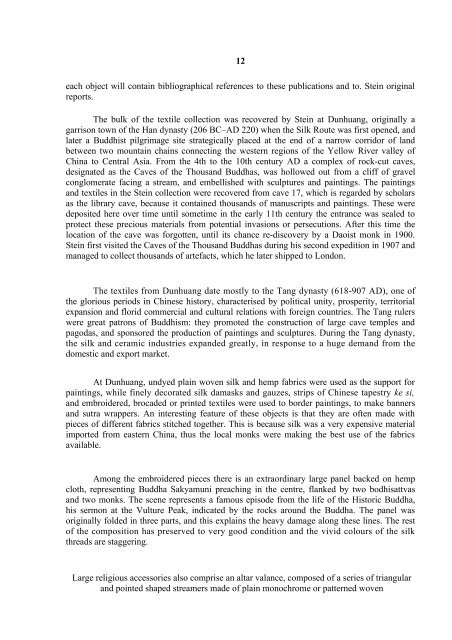download - OATG. Oxford Asian Textile Group
download - OATG. Oxford Asian Textile Group
download - OATG. Oxford Asian Textile Group
- No tags were found...
You also want an ePaper? Increase the reach of your titles
YUMPU automatically turns print PDFs into web optimized ePapers that Google loves.
12each object will contain bibliographical references to these publications and to. Stein originalreports.The bulk of the textile collection was recovered by Stein at Dunhuang, originally agarrison town of the Han dynasty (206 BC–AD 220) when the Silk Route was first opened, andlater a Buddhist pilgrimage site strategically placed at the end of a narrow corridor of landbetween two mountain chains connecting the western regions of the Yellow River valley ofChina to Central Asia. From the 4th to the 10th century AD a complex of rock-cut caves,designated as the Caves of the Thousand Buddhas, was hollowed out from a cliff of gravelconglomerate facing a stream, and embellished with sculptures and paintings. The paintingsand textiles in the Stein collection were recovered from cave 17, which is regarded by scholarsas the library cave, because it contained thousands of manuscripts and paintings. These weredeposited here over time until sometime in the early 11th century the entrance was sealed toprotect these precious materials from potential invasions or persecutions. After this time thelocation of the cave was forgotten, until its chance re-discovery by a Daoist monk in 1900.Stein first visited the Caves of the Thousand Buddhas during his second expedition in 1907 andmanaged to collect thousands of artefacts, which he later shipped to London.The textiles from Dunhuang date mostly to the Tang dynasty (618-907 AD), one ofthe glorious periods in Chinese history, characterised by political unity, prosperity, territorialexpansion and florid commercial and cultural relations with foreign countries. The Tang rulerswere great patrons of Buddhism: they promoted the construction of large cave temples andpagodas, and sponsored the production of paintings and sculptures. During the Tang dynasty,the silk and ceramic industries expanded greatly, in response to a huge demand from thedomestic and export market.At Dunhuang, undyed plain woven silk and hemp fabrics were used as the support forpaintings, while finely decorated silk damasks and gauzes, strips of Chinese tapestry ke si,and embroidered, brocaded or printed textiles were used to border paintings, to make bannersand sutra wrappers. An interesting feature of these objects is that they are often made withpieces of different fabrics stitched together. This is because silk was a very expensive materialimported from eastern China, thus the local monks were making the best use of the fabricsavailable.Among the embroidered pieces there is an extraordinary large panel backed on hempcloth, representing Buddha Sakyamuni preaching in the centre, flanked by two bodhisattvasand two monks. The scene represents a famous episode from the life of the Historic Buddha,his sermon at the Vulture Peak, indicated by the rocks around the Buddha. The panel wasoriginally folded in three parts, and this explains the heavy damage along these lines. The restof the composition has preserved to very good condition and the vivid colours of the silkthreads are staggering.Large religious accessories also comprise an altar valance, composed of a series of triangularand pointed shaped streamers made of plain monochrome or patterned woven
















